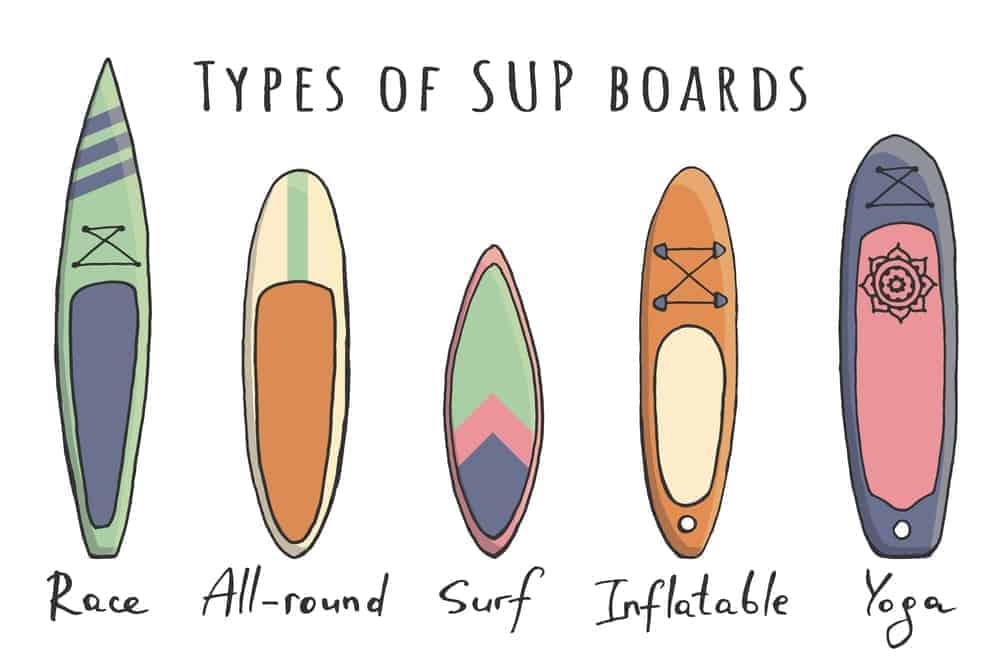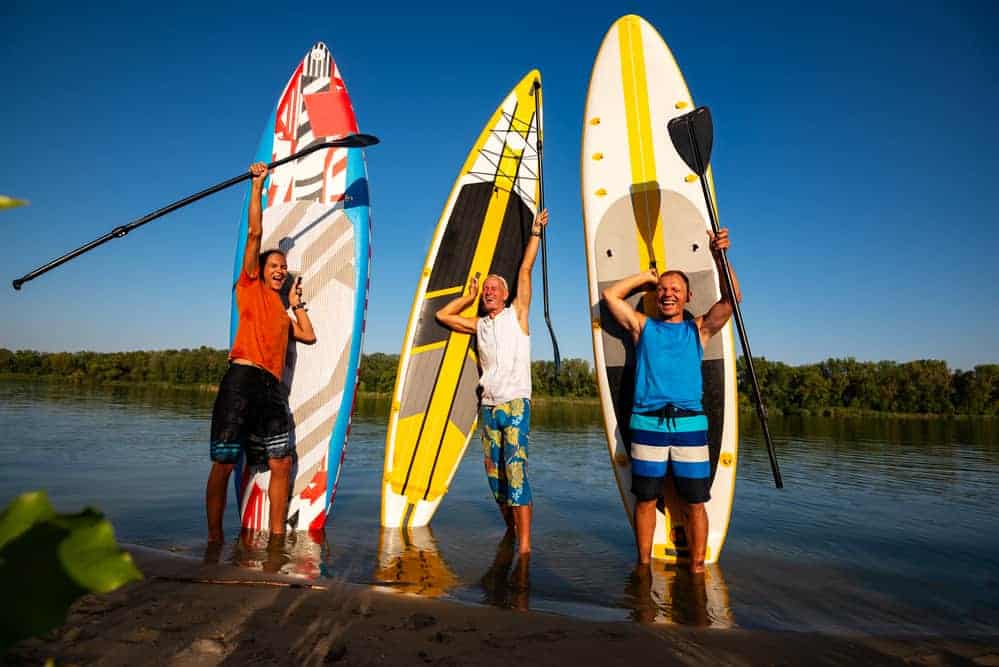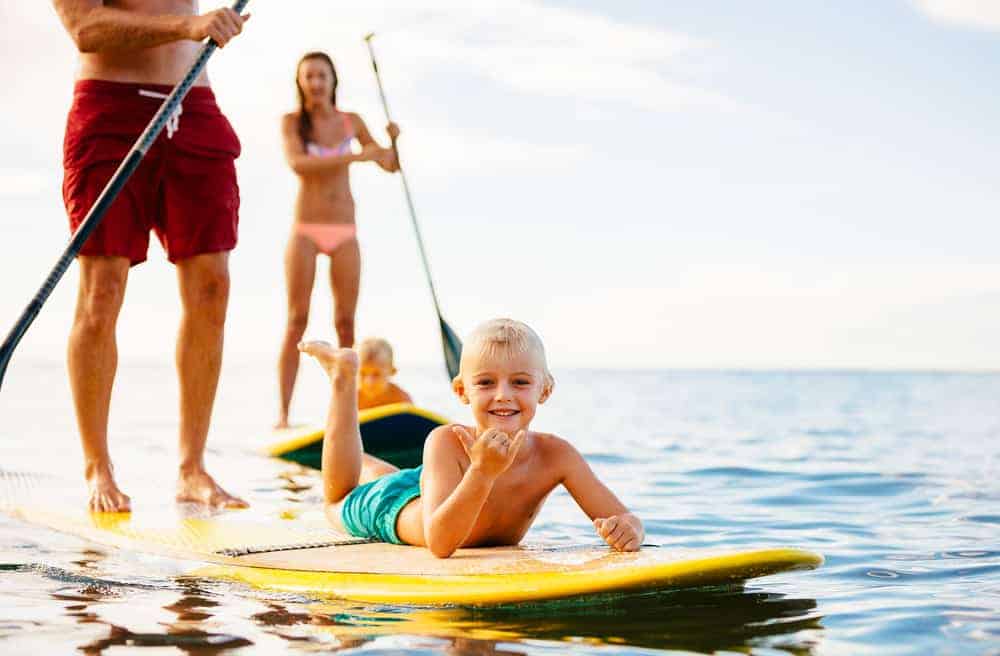Stand up paddleboarding — or SUP — is an activity that can be fun for everyone. You can paddle across a calm lake or surf the ocean waves. But what is the best SUP for you?
Regardless of what your wants and needs are, there’s most likely a paddle board out there that’s suited to your needs.
Different Types of SUP Boards

Fishing SUP
Fishermen have increasingly used paddle boards as opposed to boats as they let them see further down into the water. This can be a great advantage when trying to catch fish.
You’ll need more balance when using a paddle board in comparison to a kayak but paddle boards are far easier to transport.
Surf SUP
Paddle boards built specifically for the purpose of surfing are generally shorter and have narrow noses. The narrow shape of the paddle board makes it easier for you to maneuver the waves but they are a bit slower than surfboards.
Surfers started using paddle boards so that it would be easier for them to catch the waves. It’s worth noting that paddle boards are less stable in the water in comparison to surfboards which is why you should refrain from using one if you’re a beginner.
While the surfing community was at first reluctant to accept the paddle board trend, it has since grown in popularity. The fact that you’re able to use paddles helps you cover greater distances as well as see waves that are further away.
All-round SUP
All-round boards tend to be thicker, wider, and longer than the models built for surfing. This type of board is great for beginners as their versatility allows you to try out various aspects of the sport.
The boards are wide and very stable which makes them good for ocean touring and flat water paddling. At the same time, they still provide good performance when used for surfing.
Racing SUP
While most people enjoy the calmness of paddling through a lake, others like to have a more exciting experience with their paddleboard. In the spirit of adrenaline hunting, paddleboard users have begun organizing races around the world.
If you plan on getting into paddle board racing, you should find a longboard that is built with speed in mind. A large fin is commonly found on racing boards to help them with tracking.
Competing at a high level requires strength and balance which makes paddleboard racing a great way to stay in shape.
Touring Boards
Even though paddle-boarding originally began with surfing, it is now more popular for its touring aspect. Not many live close to beaches with big waves but most people aren’t too far from a calm lake that they can paddle across.
There’s something about paddling across long distances and admiring the scenery of the local waterways that makes you feel warm inside like you’re seeing your hometown for the first time. You can paddle on lakes, rivers, bays, and even open water.

Touring is more about endurance and discipline rather than speed. You’ll be covering long distances which makes it a better workout compared to recreational paddling.
Choosing the right length
A stand up paddle board will always handle differently depending on its length. Longer boards are generally faster than shorter boards but are less maneuverable.
Try to choose a length that best suits your uses for the board.
Shortboards
Shortboards — generally under 10 feet — are great for surfing or for use by kids. Most shortboards will have a planing hull.
Shortboards are easier to maneuver than longboards which makes them a good choice for surfers. Boards that are built for kids come in at around eight feet long.
Medium boards
You’ll find that medium boards — which fall in between 10 and 12 feet — are one of the most versatile lengths. You can use them for pretty much everything from yoga to touring.
Most boards at this length have planing hulls, but you may still see the occasional displacement hull.
Longboards
Any board that is longer than 12’6” is classified as a longboard. They are great at fast paddling and long-distance touring.
Most of the boards at this length feature a displacement hull. Longboards are much faster than shortboards and medium boards and track straighter.
If you want to go fast or traverse a long distance, a longboard will always be the best choice.
Understanding weight capacity

For a board to function properly, it needs to displace enough water to compensate for your weight. This principle is the base of buoyancy and is what allows ships of over half a million tons to float.
Many things can impact the weight capacity of your board including its length, width, and thickness.
Volume
The volume of a board — which is measured in liters — will give you an idea of its ability to float while carrying weight. SUP boards with higher volumes can support more weight.
You can find the volumes of numerous boards on REI.com — one of the best sites for those who love the outdoors.
Paddle board weight limit
Every SUP board has its own weight limit. This is often listed in pounds on American boards and kilograms on European models.
Exceeding the weight limit will have your board riding too low in the water and thus making it harder to paddle due to an increase in drag.
Bear in mind that while your body may not surpass the weight limit, your board may still ride too low if you don’t factor in the added weight of your gear, drinking water, and anything else that you’ll be carrying on you.
Volume and weight capacity as it relates to hull type
When it comes to weight capacity, planing hulls tend to be more forgiving when overloaded in comparison to displacement hulls. That said, if you measure your weight carefully, you should have no problems using either one.
Conclusion
Buying your first stand up paddle board may be scary, but you’ll soon find that the cost is well worth it for all the fun you’ll have. Do your research before buying a paddle board and get one that best suits your needs.
Don’t choose a board just because it looks cool; it has to perform well when you use it. We hope that you’ve learned a thing or two from our article, now get out there and start paddling!
